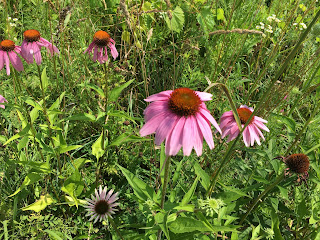 |
| Monarch Chronicles |
17 July
The 45 minute drive south of Madison to Albany becomes a pleasant one past the belt line and on into Oregon. Even though the Madison capitol can still be seen in the rearview mirror at points, five six miles away, as it is the tallest building in the metro area, the traffic is quickly forgotten and rural Wisconsin opens to its green pastures of corn and farmhouses. Freeways soon turn to country roads and, most important to this project, roadsides, even if mowed, often become small stages for prairie flowers and a lot of common milkweed, the essential plant that we are looking for in this project. Orange is the color flavor most noticed at this time of year – some butterfly milkweed in patches along the road, but the day is for the orange lily which seems to find a residence in country front yard and roadside alike. I follow Google maps through Brooklyn, a clean quaint Wisconsin town, and head south toward Albany where the Albany Wildlife Area is located just a mile or two away from the city. The task is the butterfly walk, a coordinated straight line to be walked from two points at either side of the plot. This plot, over 4 acres, so on the larger side of the options offered, is set aside by the DNR as non agriculture and see no signs for hunting, although the next plot over the sign for the Wildlife Area stands and a permitted hunting sign is attached. I park the car in a wheel rutted ditch, spray on the Off, and begin a walk through at least shoulder high Bergamot and Field Thistle
that looks quite pretty at its head, but the body prickly and I try to step near its stem bottom to push it aside. I find quickly that this is an ideal field for citizen science, a near bouquet of plants and wildflowers with intermittent clusters of common milkweed, all ideal nectar plants for monarchs, bees all over the place, and vividly conspicuous nectaring moths. These little creatures, if they haven't been seen in action before, are a strange combination of bee-backed and hummingbird, somewhere in between at first sight, and hover around the Bergamot sampling. The redwings, as usual, aggressively flap above the head, protecting even the idea of their territory; one is chased by what looks like a swallowtail butterfly, big, black, fast and not afraid to push its snout into the bird. The behind the scenes rivalries quickly show themselves when you are in the center of a wild field that has grown above the height of your head. I examine as much of the milkweed that I come across on my Pollard walk as I can. Many leaves have been nibbled at but not a single instar along my own designated transect at bearing 285 degrees. I do however run across four monarchs incidental, that is, off in the
distance. Three seem to be large and mature, one was of smaller size. Each flying in the distance, it seems possible that these were Viceroys, but hard to tell without the rear stripes in full detail. Much white aster, purple coneflower, black eyed Susans and what looks like Queen Anne's Lace along the way. Bees in work mode fill the airwaves. Near the end of the field, wild raspberry vines make the rest of the transect virtually impossible – one of the great tricks of nature – the voluptuous red berries tucked back in the thorned vines would take wings to sample. As I walk back along the roadside to the car, the landscape shows itself more clearly now, fields to the left and right agriculture and hunting, but this field, untouched, a disturbance itself, ironically, in relation to the rest of the usage surrounding, is a butterfly haven. If anybody needs evidence that it takes only 4 acres to let pollinators thrive, come and take a look, wear long pants and sleeves, and see how easily conservation works.


No comments:
Post a Comment